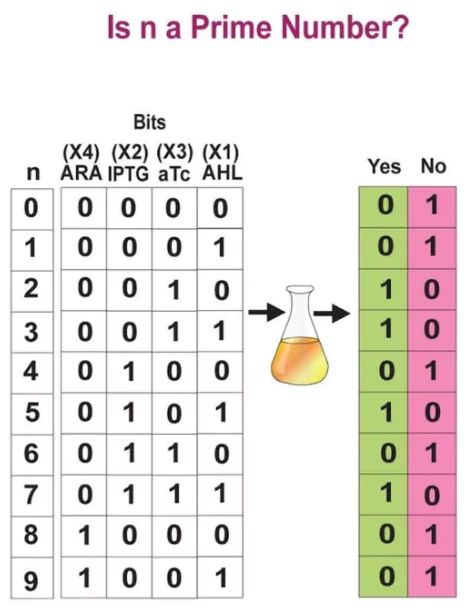Scientists at Saha Institute of Nuclear Physics, Kolkata, have built bacterial computers to perform computational tasks
About Bacterial Computers (or Cell-Based Computers)
- Bacterial computers are a form of biocomputers where living bacterial cells, like Escherichia coli, are genetically engineered to perform computational tasks.
- These computers use the natural processes of cells, such as gene regulation and protein expression, to solve problems.
- Instead of relying on silicon chips and electricity like conventional computers, bacterial computers use:
Enroll now for UPSC Online Course
Artificial Neural Networks (ANNs)
- Artificial Neural Networks (ANNs) are a subset of artificial intelligence that are designed to mimic the way the human brain processes information.
- They are composed of interconnected nodes, called artificial neurons, which are organized into layers.
- These neurons process information and make decisions based on the input they receive.
- Example: Self-Driving Cars:
- Perception: ANNs process sensor data (cameras, lidar, radar) to perceive the environment, including objects, traffic signs, and pedestrians.
- Decision Making: ANNs make real-time decisions about steering, acceleration, and braking, ensuring safe and efficient navigation.
|
-
- Genetic Circuits: Engineered DNA sequences act like software to direct the bacteria.
- Chemical Inputs and Outputs: Problems are encoded in the form of chemical signals, and the bacteria respond by producing fluorescent proteins or other measurable outputs.
Mechanism and Functioning of Bacterial Computers
Bacterial computers behave like artificial neural networks (ANNs).
- Artificial Neural Networks (ANNs):
- ANNs consist of layers of processing units called nodes.
Bactoneurons:
- Bactoneurons are genetically engineered bacteria that function as artificial neurons in a biological neural network, processing chemical signals as inputs and producing outputs like fluorescent proteins.
- These engineered bacteria can be combined to form computational systems capable of solving problems, similar to how artificial neural networks in traditional computers work.
|
-
- Each node processes inputs, performs computations, and produces outputs, which may serve as inputs for subsequent nodes.
- The complexity of tasks increases with the number of layers in the ANN.
- Genetic Circuits in Bacteria:
- Bagh’s team introduced transcriptional genetic circuits in Escherichia coli bacteria.
- During transcription, bacteria convert DNA into RNA and subsequently into proteins.
Check Out UPSC CSE Books From PW Store
About E.coli
- Escherichia coli (E. coli) is a rod-shaped bacterium of the Enterobacteriaceae family, commonly found in the intestines of humans and animals.
- While most strains are harmless or even beneficial, some can cause severe infections and illnesses.
- It is the most commonly isolated bacteria from patient samples, present in 23.19% of samples from tertiary care hospitals.
|
-
- Synthetic promoters and transcription factors were added to bacteria to trigger specific genetic responses, forming mechanisms like feedback and feed-forward loops, similar to those in machine learning models.
- Bactoneurons as Single-Layered ANNs: Four chemical inducers acted as inputs to the bactoneurons, determining whether the circuits were switched “on” or “off.”
- A combination of 14 bactoneurons was created to perform specific computational tasks.
Input and Output Mechanisms
- Binary Coding of Inputs: Problems were translated into binary code, with the presence of chemical inducers represented as ‘1’ and their absence as ‘0.’
- For example:
- Presence of three chemicals (111) and absence of one (0) signified the number 7.
- Absence of three chemicals and presence of one indicated the number 4.
- Fluorescent Proteins as Outputs:
- The presence of red or green fluorescent proteins in the bacteria signified outputs, interpreted in binary.
- For instance:
- Green fluorescence (1) but no red fluorescence (0) indicated “yes.”
Computational Capabilities

- Prime Number Identification:
- When asked if 7 is a prime number, the bacterial computer responded “yes” by expressing green fluorescent protein but not red.
- Complex Mathematical Tasks:
- Whether a number between 0 and 9 was a perfect power (e.g., 8=2^3).
- Whether adding three to an integer would create a prime number (e.g. “is 2 + 3 a prime number?”)
- Whether a letter between A and L was a vowel.
- Application in Optimization Problems:
- Solved problems like finding the maximum number of pie pieces from a given number of cuts.
- Outputs were interpreted using additional fluorescent proteins, such as blue and orange, providing solutions in binary form, later converted to decimal.
Potential Applications of Bacterial Computers
- Computing: Bacterial computers can eventually be used to outsource computational tasks, reducing reliance on traditional silicon-based computers.
- Medical Technology: Engineered bacteria can operate autonomously in the human body to diagnose and act on diseases.
- The technology has potential applications in early cancer detection, precise treatment delivery, and molecular diagnostics.
- Space Exploration:
- Enables resource utilization and autonomous operations on planets like Mars.
- Bacteria could adapt to local conditions without human intervention.
- Microscale Computation:
- Overcomes the limitations of silicon-based microprocessors.
- Advances miniaturised computing for specialised tasks.
- Basic Science: Raises philosophical and scientific questions about intelligence, as bacteria perform traditionally human or computer-specific tasks.
Check Out UPSC NCERT Textbooks From PW Store
Comparison of Cell-Based Biocomputing and Normal Computing
| Aspect |
Cell-Based Biocomputing |
Normal Computing |
| Basic Unit |
Living cells (e.g., bacteria, engineered microbes). |
Silicon-based transistors and integrated circuits. |
| Mechanism |
Relies on biochemical processes (e.g., gene regulation, transcription). |
Operates through electronic signals (voltage, binary logic). |
| Energy Efficiency |
Highly energy-efficient; bacteria require minimal energy to operate. |
Energy-intensive; requires significant power for computation. |
| Size |
Micron-scale; significantly smaller than silicon chips. |
Limited by semiconductor fabrication technology. |
| Speed |
Slower due to reliance on biochemical reactions. |
Extremely fast; processes billions of operations per second. |
| Flexibility |
Modular and adaptable; genetic circuits can be reconfigured. |
Rigid hardware architecture; requires redesign for customization. |
| Applications |
Useful for biochemical sensing, autonomous decision-making in healthcare, and space exploration. |
Widely used in general-purpose tasks such as data processing, gaming, and AI. |
| Cost |
Potentially low-cost due to the use of biological materials. |
Expensive to manufacture and maintain advanced chips. |
| Durability |
Sensitive to environmental changes (e.g., temperature, pH). |
Durable in controlled environments, resistant to external factors. |
| Ethical Concerns |
Raises questions on the use of living organisms for non-natural purposes. |
Limited ethical concerns unless applied to sensitive domains (e.g., AI ethics). |
| Computational Problems |
Limited to solving specific problems (e.g., yes/no questions, optimization tasks). |
Versatile; can solve complex multi-dimensional problems. |
| Environmental Impact |
Biodegradable and eco-friendly. |
Contribute to electronic waste and environmental degradation. |
Significance and Future Prospects
Scientific Implications
- Redefining Intelligence: The research shows that single-celled organisms can perform complex tasks. This challenges our current definition of intelligence.
- Understanding Cognitive Functions: By studying bacterial computation, we can learn more about the biochemical processes that could support cognitive functions in humans and animals.
- New Problem-Solving Methods: Bacterial computers can solve problems like pattern recognition. This opens the door for using biological systems in computing.
Vision for the Future
- Advanced Bacterial Computers: Scientists aim to create more advanced bacterial computers. These systems could solve complex problems in molecular biology.
- Integration with Biotechnology: Bacterial computers could be used in medicine and diagnostics. They could help with real-time data analysis and decision-making.
- Distributed Biocomputing Systems: There is potential for networks of bacterial computers. They could collaborate to solve large-scale problems in areas like space exploration.
Check Out UPSC Modules From PW Store
About Biocomputers
- Biocomputers are a research area that combines brain cultures grown in a lab with modern computing methods.
- Biocomputers can be used for complex information processing, and can help with:
- Understanding the biological basis of human cognition, learning, and memory
- Decoding the pathology of degenerative diseases such as Parkinson’s disease and microcephaly
- Drug development
- Working:
-
- Biocomputers combine brain organoids with machine learning.
- The organoids are grown inside flexible structures with electrodes that record the firing patterns of neurons and deliver electrical stimuli.
- These stimuli mimic sensory stimuli and are later analyzed by machine-learning techniques.
|
Concerns with Bacterial Computing
- Ethical Issues: Using living organisms for computational purposes raises moral and ethical questions about the manipulation of life for non-natural functions.
- Environmental Risks: The accidental release of genetically modified bacteria into the environment could disrupt ecosystems or lead to unintended consequences, such as the spread of synthetic genes.
- Stability and Reliability: Biochemical reactions in bacteria can be influenced by environmental factors like temperature, pH, and nutrient availability, affecting the consistency and accuracy of computations.
- Biosafety Concerns: Engineered bacteria may evolve or exchange genetic material with natural microbes, potentially creating harmful strains.
- Scalability Limitations: Current bacterial computing systems are limited in the complexity and scale of problems they can handle, making them unsuitable for high-demand applications.
- Regulatory Challenges: The use of genetically modified organisms (GMOs) for computing will require strict regulatory frameworks to address safety, ethical, and societal concerns.
Way Forward for Bacterial Computing
- Enhanced Biosafety Measures: Develop stringent containment protocols and safeguards to prevent accidental release of genetically modified bacteria into the environment.
- Scalable Design: Focus on improving the scalability of bacterial computing systems to handle more complex computational tasks efficiently.
- Integration with Traditional Computing: Combine bacterial computing with conventional silicon-based systems to harness the strengths of both technologies for hybrid computing solutions.
- Public Awareness and Ethical Discourse: Encourage transparent discussions on the ethical implications and societal impacts of bacterial computing to build public trust and acceptance.
- Regulatory Frameworks: Establish clear regulations for research, development, and application of bacterial computing, ensuring compliance with ethical and biosafety standards.
- Application-Oriented Research: Focus on developing real-world applications, such as medical diagnostics, environmental monitoring, and space exploration, to demonstrate the practical benefits of the technology.
Enroll now for UPSC Online Classes
Conclusion
Bacterial computing combines biology and technology, offering promising solutions to computational challenges at a microscale. While concerns around ethics, safety, and scalability remain, continued research and innovation can unlock its potential for transformative applications in healthcare, space exploration, and beyond.
![]() 20 Nov 2024
20 Nov 2024


